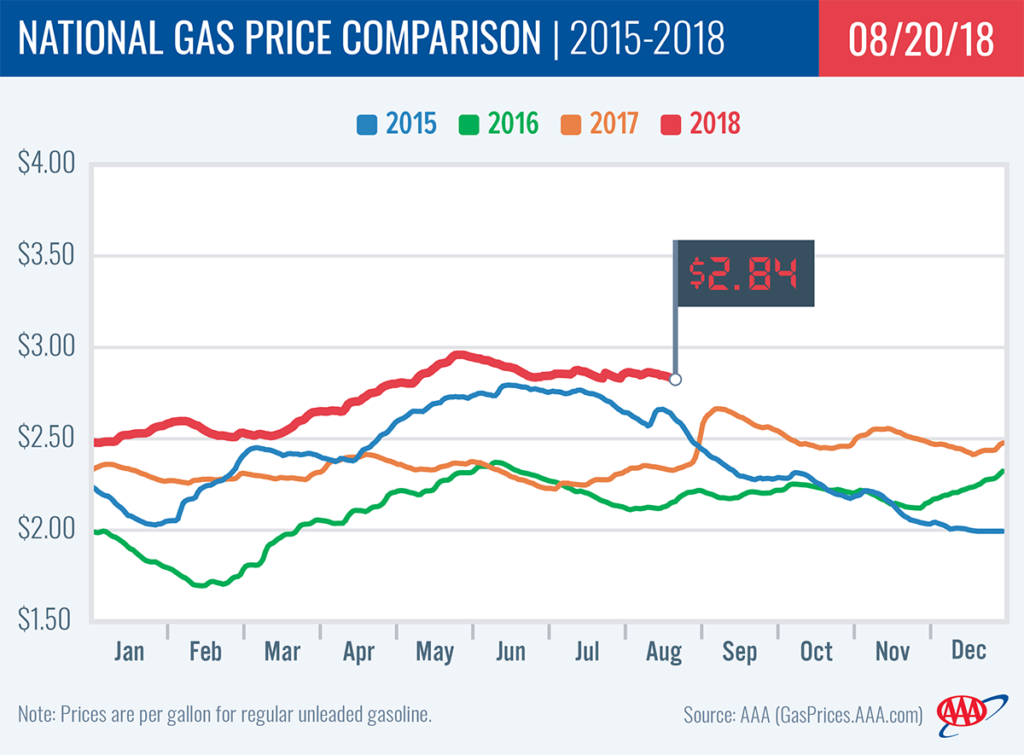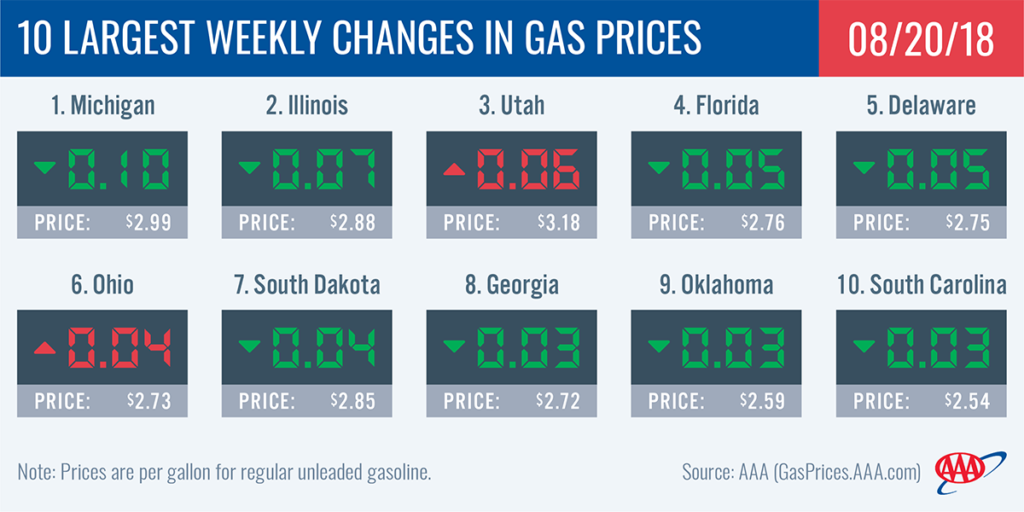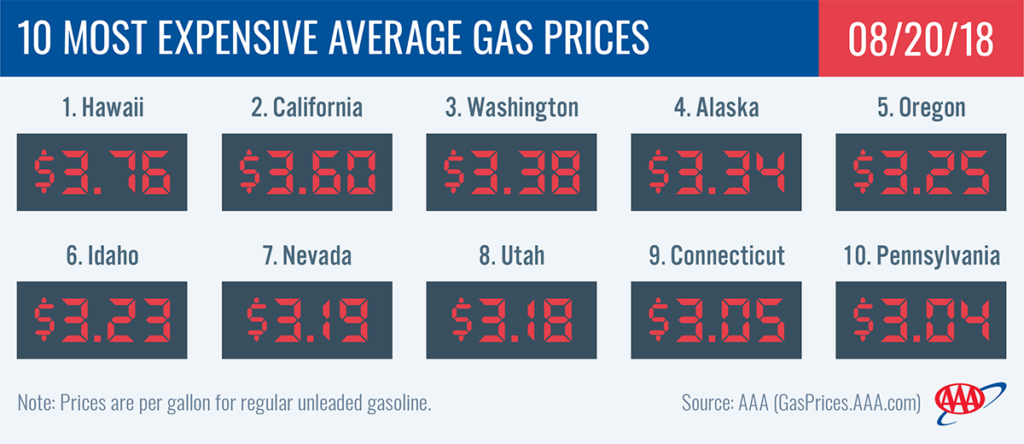As summer slows to an end, gas prices across the country are getting less expensive. Today’s national gas price average is $2.84, which is three cents less than at the beginning of the month. With the exception of a handful of states, the majority of motorists are seeing slow, but steady pump price drops during the last few weeks.
“Compared to July, consumer demand for gasoline is weaning and prices are following suit,” said Jeanette Casselano, AAA spokesperson. “The national average is expected to keep moving lower, especially with the switchover to lower grade gasoline in September.”
In September, gas stations will start selling winter-blend gasoline. This blend, which is cheaper to produce, contains a fuel that evaporates at low temperatures for vehicle engines to operate properly, especially when the engine is cold.
The national gas price average is saving motorists two-cents on the week and one-cent on the month, but motorists are paying 50-cents more than this time last year.
Quick Stats
- The nation’s top 10 most expensive markets are: Hawaii($3.76), California ($3.60), Washington ($3.38), Alaska ($3.34), Oregon ($3.25), Idaho ($3.23), Nevada ($3.19), Utah ($3.18), Connecticut ($3.05) and Pennsylvania ($3.04).
- The nation’s top 10 largest weekly changes are: Michigan (-10 cents), Illinois (-7 cents), Utah (+6 cents), Florida (-5 cents), Delaware (-5 cents), Ohio (+4 cents), South Dakota (-4 cents), Georgia (-3 cents), Oklahoma (-3 cents) and South Carolina (-3 cents).
West Coast
Motorists in the West Coast region are paying some of the highest pump prices in the country: Hawaii ($3.76), California ($3.60), Washington ($3.38), Alaska ($3.34), Oregon ($3.25), Nevada ($3.19) and Arizona ($2.87). When compared to last week, most pump prices in the region are down. Alaska (-3 cents) saw the largest drop, followed by Arizona and Oregon dropping two cents each. Idaho (+2 cents) saw the largest price increase.
According to the Energy Information Administration’s (EIA) petroleum status report for the week ending on August 10, inventories of gasoline in the region fell by 100,000 bbl. They now sit at 30.3 million bbl, which is nearly four million bbl lower than total levels at this time last year. Slowing demand has reduced stocks slightly in the region, but as supplies tighten, any supply shocks could make the market more volatile this week and force prices to spike.
Great Lakes and Central
Gas prices are as much as a dime cheaper for motorists in the Great Lakes and Central states, with the exception of Ohio (+4 cents) and Indiana (+1 cent) on the week. Michigan (-10 cents), Illinois (-7 cents) and South Dakota (-4 cents) carry the largest declines in the region.
Prices are pushing down as the EIA reports inventories (at 53 million bbl) are not only seeing a year-over-year surplus, but levels are ahead of the five-year average. In fact, this is the highest inventory reported for the region in the mid-August timeframe since 1999.
However, strong inventory levels may not be a consistent trend. The region’s refinery rates slowed slightly on the week ahead of the start of turnaround season, which will ultimately bring cheaper gas prices for motorists this fall and winter.
South and Southeast
All motorists in the South and Southeast region are saving pennies at the pump with prices as much as a nickel cheaper on the week in Florida. Georgia, Oklahoma and South Carolina all saw their gas price averages drop three cents since last Monday. These four states land on the top 10 list of states with the largest weekly change.
Motorists in the South and Southeast region are seeing cheaper prices at the pump as inventories built for a second week in a row, reported the EIA. Adding half a million bbl, total inventories sit at 80.1 million bbl, which is the highest level seen since the Independence Day holiday.
Despite this week’s cheaper prices, some motorists in the South and Southeast are paying as much as 52-cents more to fill up compared to last August: New Mexico (+52 cents), Florida (+52 cents) and Georgia (+51 cents). Regardless, the region continues to carry some of the cheapest state gas price averages in the country.
Mid-Atlantic and Northeast
All motorists in the Mid-Atlantic and Northeast are paying one to five cents less this week to fill-up. With a nickel drop, Delaware lands on the top 10 states list with the largest changes in gas prices on the week. Maryland, Washington, D.C. and Tennessee (-3 cents) had the second largest drop in the region.
Mid-Atlantic and Northeast state gas price averages range from as expensive as $3.05 in Connecticut to as cheap at $2.60 in Virginia.
With an 800,000 bbl draw, gasoline inventory levels now sit at 63.2 million bbl – the lowest levels reported in the region by the EIA since early May.
Rockies
Utah (+5 cents) and Idaho (+2 cents) are two of only four states in the country to see gas prices jump on the week. The increases are high for the region especially considering gas price averages held steady since last Monday in Wyoming ($2.95), Montana ($2.94) and Colorado ($2.80).
Gasoline inventories drew down for a fourth week dropping levels to the lowest of the year for the region. At 6.5 million bbl, inventories are on par with the five-year average. As previously reported, gas prices will likely push up as the tourism season draws to a close.
Oil market dynamics
At the close of Friday’s formal trading session on the NYMEX, WTI increased 45 cents to settle at $65.91. Oil prices ended the week with slight gains due to a softening dollar, after tumbling midweek following new data from the EIA that showed domestic crude oil inventories grew by 6.8 million bbl last week.
The unusually high growth in crude inventories caught market observers by surprise, raising concerns that summer demand may be waning. At 414.2 million bbl, crude inventories in the U.S. are about 52 million bbl lower than they were at this point last summer, which has contributed to higher gas prices this summer. Domestic crude production topping 10.9 million b/d and imports surging to just over 9 million b/d gave total crude inventories their boost last week. If these trends continue into this week, crude inventories may show more growth, which would likely push domestic crude prices lower.
In related news, according to Baker Hughes, Inc., the U.S. added no oil rigs last week, leaving the total unchanged at 869. Currently, there are 106 more active rigs this year than last year at this time.
Motorists can find current gas prices along their route with the free AAA Mobile app for iPhone, iPad and Android. The app can also be used to map a route, find discounts, book a hotel and access AAA roadside assistance. Learn more at AAA.com/mobile.



